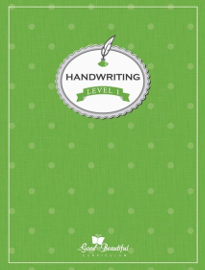The Good and the Beautiful has published a handwriting series for students in pre-kindergarten through seventh grade. It teaches traditional forms of printing and cursive, with the transition to cursive taught in Handwriting: Level 3. The content is uplifting and positive, and it includes Christian content of a generic nature.
Except for Handwriting: Level 3 and Level 4, the books are printed in black and white with one color. Level 3 and Level 4, printed in full color, add a seven-color dot system to teach letter formation. All books are available as printed books and PDFs.
As you would expect, these handwriting books teach the forms of the letters and provide space for tracing and copying. The fonts and line spaces gradually decrease in size.
Each book in the series has 100 pages, so there are three or four pages per week to complete. That might sound like a lot of handwriting practice, but these books range wider than most handwriting books. Copywork is an important feature, and the copywork material includes poetry, Scripture verses, grammar rules, spelling rules, and adages such as “Never give up” and “Be kind always” (Level 5, p. 33). Pages sometimes have puzzles, drawing activities, and occasional evaluation forms. Once in a while, students are reminded about the basics such as on page 84 in Level 4 where it says,
Practice fully closing letters “g,” “a,” and “p” by copying the words below in print. After you write each word, check to see if the letters “g,” “a,” and “p” are fully closed.
Doodles & Pre-Writing for Littles: Part 1 prepares students for writing by helping them develop dexterity and control as they trace and fill in all sorts of lines and forms. The shapes of capital letters are introduced, but children are not expected to write the letters at this stage. Doodles & Pre-Writing for Littles: Part 2 continues with all sorts of tracing activities in the first of three sections of lessons. The second section introduces the capital letters to be traced. The third section has challenging tracing exercises plus some that have children will fill in drawings without dotted lines. A bonus section at the back of the book has children look for particular items within complex drawings.
Level K teaches the formation of letters and numbers. By the end of the course, students are writing short words and sentences. Coloring and drawing are purposely included in the first two courses to help children develop fine motor skills.
Level 1 and Level 2 both reteach the formation of letters for printing, still using forms for children to trace and copy. The amount of time spent writing words and sentences gradually increases.
Second editions for Level 3 and Level 4, introduce a colorful dot system for teaching the formation of letters, with the dots arranged to reflect the sequence of colors in the rainbow. Full color in these books is used only in regard to the dot system. Level 3 is the starting place for students just beginning to learn cursive. The books continue to reinforce printing skills although they concentrate primarily on teaching cursive.
Beginning with Level 3, students are sometimes asked to copy a small drawing in the box provided on the page. Students can color these and other drawings with colored pencils.
Level 5 through Level 7 provide practice only with cursive. Some instruction stretches into other subject areas: Level 6 adds practice writing the names of the states and their capitals, and Level 7 has them write the names of Canadian provinces and regions. Quotations from famous people are added in Level 7.
This series has more variety than most handwriting courses along with plenty of handwriting practice. While there might be more content in these courses than some students need or want, it will be very helpful to others.









